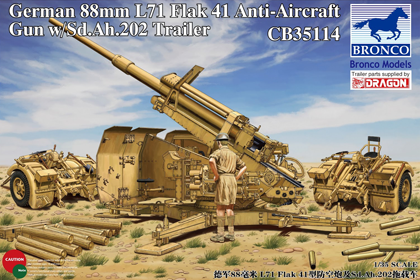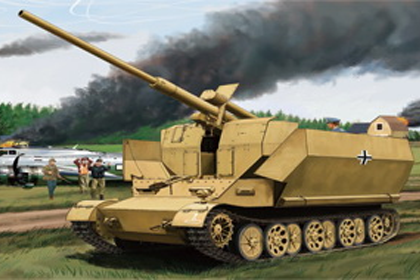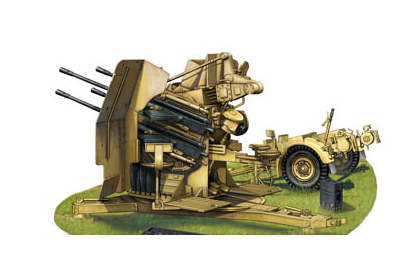This is the Bronco AB 3562 kit in 1/35 scale, of the ‘British Field Accessories set’.

Where I got it
- Stoppel Hobby (October 2018)
This is the Bronco AB 3562 kit in 1/35 scale, of the ‘British Field Accessories set’.

This is the Bronco 35114 kit in 1/35 scale, of the ‘German 88mm FlaK 41 Anti-Aircraft Gun w/Sd.Ah.202 Trailer’.

With the increase of aircraft performance, many armies developed dedicated anti-aircraft guns with a high muzzle velocity – allowing the projectiles to reach greater altitudes. It was this muzzle velocity, combined with a projectile of high weight, that made the 8.8 cm (88mm or “acht-acht”) FlaK one of the great World War II anti-tank guns.
The first such German gun was introduced in 1917, and it used the 88mm caliber, common in the Kaiserliche Marine German navy.
This is the Bronco 35174 kit in 1/35 scale, of the ‘German Versuchsflakwagen fur 8.8cm FlaK 37 auf Sonderfahrgestell’.

The Versuchsflakwagen fur 8.8cm – FlaK 41 – was also known as the Grille 10 named after the Cricket insect. The Grille 10 was the first in a series of armoured self propelled guns dating from 1942.
The hull used components from several vehicles but mainly the Panzer IV and Sd.Kfz.9. The gun was mounted on the rear hull and protected by hinged side armour which folded down when in action.
Three prototypes were built in 1944, first mounting the 8.8cm FlaK 37 and later the FlaK 41. One vehicle was refitted with the FlaK 37 and sent to Italy for combat trials, serving with Flakartillerie Abt (Sf) 304 attached to the 26th Panzer Division. Trials were considered a success and a second series of Grille 10’s were ordered, but on Panther hull.
Other members of the Grille family were built on the Tiger II hull including the Grille 17 with 17cm gun, Grille 21 with 21cm mortar, Grille 30 with 30.5cm mortar and the Grille 42 with 42cm mortar.
This is the Bronco 35062 kit in 1/35 scale, of the ‘German Versuchsflakwagen für 8.8cm FlaK 41’.

The Grille 10 was a heavily modified Pz.Kpfw.IV, with track work from the Sd.Kfz.9 artillery tractor. It was originally designed to carry an 8.8cm anti-tank gun. However the design was changed in 1942 and three prototype vehicles were built mounting the 8.8cm FlaK 37 anti-aircraft gun. These were designated Versuchsflakwagen (Vfw) für 8.8cm FlaK 37, and were ready for testing in late 1943.
The idea was to provide a highly mobile anti-aircraft gun to the Panzer Divisions, protecting the tanks from air attack. In 1944 these vehicles were fitted with the 8.8cm FlaK 41, though a single vehicle was refitted with a FlaK 37 and sent for battle testing in Italy. The two remaining Vfw fur 8.8cm FlaK 41 vehicles were successful in their trials, but the war ended before mass production could begin in 1945.
This is the Bronco 35057 kit in 1/35 scale, of the ‘German 2cm Flakvierling 38’.

In 1940 the 2cm Flakvierling (quad mounting) 38 was officially adopted by the German army as its standard light anti-aircraft weapon. Mauser was made responsible for the development work and subsequent production of this variant. All four guns could be fired with a combined rate of fire of 800 rpm, or the weapons could be fired in pairs.
During the war it was used either vehicle mounted or on its familiar 4-gun Sd.Ah.52 towed carriage. As the war progressed, ammunition was developed for ground use against vehicles and ground works.
This is the Bronco 35103 kit in 1/35 scale, of the ‘German Telemeter KDO Mod 40’.

Introduced by the German military in 1941 this small director was used by all three services and could be modified for use with almost any anti-aircraft weapon. In the field the director used a 5-man crew, two men are required to input azimuth and elevation data. A third man sets the slant range by means of a 4-meter stereo range finder which is mounted on top of the director. A fourth man sets the horizontal angle of approach, while the fifth man is a general operator. The time from first acquiring the target to firing the first round could be achieved in less than 30 seconds. The slant range could be up to 18,000 meters.
For transport the director is mounted on a Sd.Ah.52 special trailer, equipped with lifting devices, and towed by a light truck.